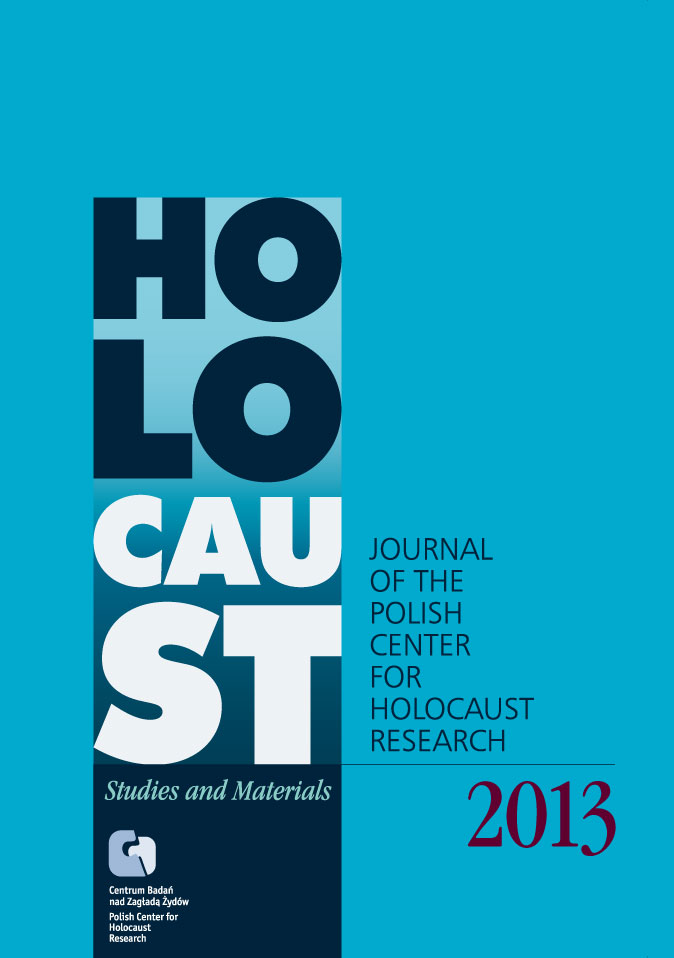Gone but not Forgotten: Archaeological approaches to the site of the former Treblinka Extermination Camp in Poland
Zagłada Żydów. Studia i Materiały, Nr Holocaust Studies and Materials (2013), Strony: 253-289
Data zgłoszenia: 2020-12-13Data publikacji: 2013-02-20
 https://doi.org/10.32927/zzsim.809
https://doi.org/10.32927/zzsim.809
Abstrakt
Public impression of the Holocaust is unquestionably centred on knowledge about, and the image of, Auschwitz-Birkenau – the gas chambers, the crematoria, the systematic and industrialized killing of victims. Conversely, knowledge of the former extermination camp at Treblinka, which stands in stark contrast in terms of the visible evidence that survives pertaining to it, is less embedded in general public consciousness. As this paper argues, the contrasting level of knowledge about Auschwitz-Birkenau and Treblinka is centred upon the belief that physical evidence of the camps only survives when it is visible and above-ground. The perception of Treblinka as having been “destroyed” by the Nazis, and the belief that the bodies of all of the victims were cremated without trace, has resulted in a lack of investigation aimed at answering questions about the extent and nature of the camp, and the locations of mass graves and cremation pits. This paper discusses the evidence that demonstrates that traces of the camp do survive. It outlines how archival research and non-invasive archaeological survey has been used to re-evaluate the physical evidence pertaining to Treblinka in a way that respects Jewish Halacha Law. As well as facilitating spatial and temporal analysis of the former extermination camp, this survey has also revealed information about the cultural memory associated with the site and how much has been forgotten about its history.
Licencja
Prawa autorskie (c) 2013 Autor & "Zagłada Żydów. Studia i Materiały"

Utwór dostępny jest na licencji Creative Commons Uznanie autorstwa 4.0 Międzynarodowe.
https://creativecommons.org/licenses/by/4.0
Inne teksty tego samego autora
- Caroline Sturdy Colls, O tym, co minęło, lecz nie zostało zapomniane: Badania archeologiczne na terenie byłego obozu zagłady w Treblince , Zagłada Żydów. Studia i Materiały: Nr 8 (2012)
Podobne artykuły
- Michał Trębacz, Karski–Zygielbojm. Historia pewnej rozmowy , Zagłada Żydów. Studia i Materiały: Nr 18 (2022)
- Zuzanna Schnepf-Kołacz, Losy pracowników niemieckiej gadzinówki „Nowy Kurier Warszawski” w świetle powojennych procesów z dekretu sierpniowego , Zagłada Żydów. Studia i Materiały: Nr 2 (2006)
- Adam Kopciowski, David A. Mandelbaum, From Lublin to Shanghai. The Miraculous Exile of Yeshivas Chachmei Lublin, tłum. Malky Heimowitz, New York: Mesorah Publications, 2012, 316 s , Zagłada Żydów. Studia i Materiały: Nr 15 (2019)
- Sławomir Buryła, Literatura polska o donosach i donosicielach , Zagłada Żydów. Studia i Materiały: Nr 2 (2006)
- Dagmara Swałtek, For an overcoat, a suitcase and an apple. Crimes against Jews hiding in the villages of Falkowa, Wieniec and Janowice in ... , Zagłada Żydów. Studia i Materiały: 2010: Holocaust Studies and Materials
- Janusz Salamon, SJ, Christian-Jewish Dialogue in the Land of Sick Imagination. On the Margins of Waldemar Chrostowski’s Book Kościół, Żydzi, Polska , Zagłada Żydów. Studia i Materiały: 2010: Holocaust Studies and Materials
- Redakcja, Od Redakcji , Zagłada Żydów. Studia i Materiały: Nr 1 (2005)
- Israel Gutman, Listy Emanuela Ringelbluma w opracowaniu Israela Gutmana , Zagłada Żydów. Studia i Materiały: Nr 1 (2005)
- Romuald Jakub Weksler-Waszkinel, Jak Pawłowski ukrywał Grinera [Sługa Mesjasza. Z ks. Grzegorzem Pawłowskim/Jakubem Herszem Grinerem rozmawia Lucyna Montusiewicz, Lublin, wyd. Gaudium 2005] , Zagłada Żydów. Studia i Materiały: Nr 1 (2005)
- Joanna Nalewajko-Kulikov, Gunnar S. Paulsson, Secret City: the Hidden Jews of Warsaw 1940-1945 , Zagłada Żydów. Studia i Materiały: Nr 1 (2005)
<< < 36 37 38 39 40 41 42 43 44 45 46 47 48 49 50 51 52 53 54 55 56 57 58 59 60 61 62 63 64 65 66 67 68 69 70 71 > >>
Możesz również Rozpocznij zaawansowane wyszukiwanie podobieństw dla tego artykułu.
 English
English
 Język Polski
Język Polski








